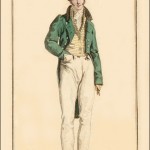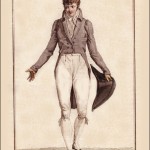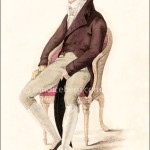Le Beau Monde, April 1808.
“Full & Half Full Dresses for April.”
The “Full Dress” of the title belongs to the gentleman on the left. “Half Full Dress” apparently belongs to the center and right figures, though I don’t know what makes them Half Full and not just Half Dress.
As was typical for this publication, the description of the lady’s dress is detailed and specific to the dress shown, though suggestions for alternate colors for the pelisse are given. With gentlemen’s dress, the description generally refers to what is currently in fashion, and does not provide specific detail about the fashions shown.
Note that the gentlemen’s evening dress, the figure on the left, shows breeches, buckled shoes, and a bicorn hat, all appropriate for evening wear. The top hat and top boots of the center figure would not have been worn at a formal evening event. Only uniformed soldiers wore boots at evening events. Top hats became acceptable with evening wear a decade or more later.
The print is described in the magazine as follows:
“LADIES’ DRESS. A plain white dress of real French cambric, made with a long train, and enriched round the bottom with a superb border of sun-flowers in needlework, and between every flower is inlet a rich footing of point lace–these flowers may be worked in colours or in white, and give a beautiful effect either way; The body of the dress is also made a degree longer than is usually worn; the back and bosom high, to wrap simply over, and fastened with a small diamond clasp,, and trimmed all round to correspond with the bottom of the dress; the sleeves are made in the bishop style, of a much lighter texture than the dress, and are made separate from the dress. A robe pelisse of a delicate pink, pea-green, lilac, or sky-blue, lined throughout with white sarsnet, and trimmed all round with a wreath of green ivy leaves. The hair is formed into graceful curls in the front of the head, with a narrow band of pink sarsnet, bound round the forehead, and shews transparently through the hair. A rich white lace handkerchief thrown carelessly over the head, and tied under the chin; gloves white kid, and shoes pea-green.
“GENTLEMEN’S MORNING DRESS. [Center figure.] In this we are scarcely at present able to point out any variety, as the coldness of the weather still renders a good great coat indispensable, and thus far precludes the opportunity of exhibiting the motley changes of fashion and taste, to any advantage. We are, however, justified in saying that light colours will certainly take the lead in the ton for coats. Waistcoats of striped Marsailles quilting will of course resume their stations as soon as the mildness of the weather will permit; and drab kerseymere or leather breeches, with brown top boos, will be as much the rage as ever.
“GENTLEMEN’S EVENING DRESS. [Left figure.] The most prevailing at present is a dark blue coat with large sized flat gilt buttons, with velvet collar, or collar of the same cloth, according to fancy; with this we see single breasted white Marsailles quilting waistcoats, black silk breeches and stocking; some few sport drab coloured kerseymere breeches and white stockings.”








